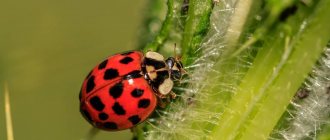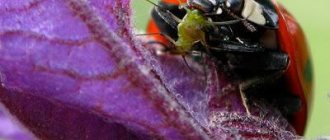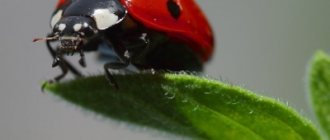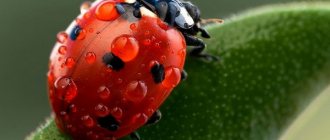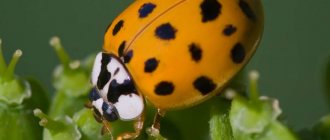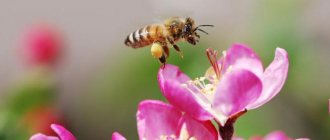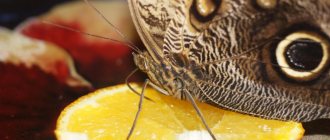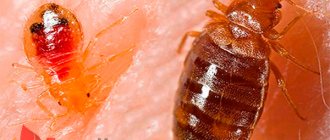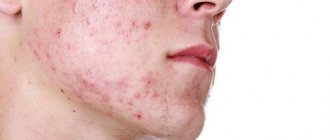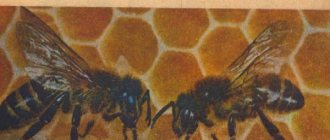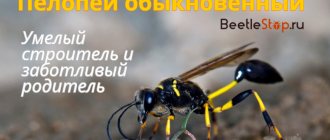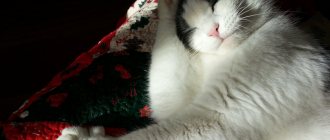Ladybug, fly to the sky, bring me bread, black and white - just not burnt
Among all the insects that live in our latitudes, it is the ladybug that enjoys the greatest respect and honor. And not only in Russia. So, in Slovenia and the Czech Republic it was called the “sun” (Slunechko), in Germany and Switzerland it is known as the “Virgin Mary’s bug”, in Latin America it is called “St. Anthony’s cow”.
The color of a ladybug's protective covering can be not only bright red, but also yellow, black, brown, white... And not all with spots. There are specks, polka dots, with squares, black and white, like a chessboard, marbled. The spots can also be of different colors and different numbers.
I’ll show you the ladybugs that I met in the Novosibirsk region.
By the way, I also have a selection of butterflies from Siberia.
Two-spot ladybug (lat. Adalia bipunctata)
The two-spotted ladybug is a highly variable coloring ladybug. Usually the elytra are red, each with one black spot. They can be completely black or black with 2-3 red spots on each elytra. The pronotum in light forms is yellow with an M-shaped black spot, in dark forms it is black with yellow or white sides. Body length 3.5-5.5 mm.
Two-spot ladybug
The ladybug is characterized by amazing mobility and the highest feeding intensity. Adult insects and their larvae can feed not only on aphids, but also on such dangerous pests as scale insects, spider mites, caterpillars of leaf beetles and their ovipositors.
Two-spot ladybug
In spring and early summer, it is found mainly in orchards, where it feeds on apple, peach and reed aphids, and also settles on other tree species. The species is very rare on herbaceous plants of this time. From mid-summer, when the number of aphids in gardens decreases, beetles disperse more or less evenly on grasses and trees in search of food. At this time they are found on cereals and other field crops.
Two-point cows, mating
The two-spotted ladybug was approved as the national insect of Latvia in 1991 by the Latvian Entomological Society.
Nutrition
These peaceful creatures for humans are very dangerous for living organisms of their size and type and are voracious predators. But even with their carnivory they bring considerable benefits to humans. After all, those whom they eat are known as malicious pests and parasites.
What do ladybugs eat ? They destroy hordes of aphids (an adult can eat about a hundred of them in a day), eat other insects, their eggs, as well as caterpillars, pupae and even butterflies.
Therefore, in order to save farmland, ladybugs are deliberately bred and dropped from airplanes in large numbers. If they lack food, they happily turn to the eggs of a well-known pest of potato plantings - the Colorado potato beetle.
But there are species of these insects whose diet includes only plant foods: flowers, leaves, pollen, and in some cases, plant fruits and mushrooms. They really sometimes become a big problem, causing damage to fields and crops growing on them.
However, such species are more common in southern Asia. In Russia they exist (for example, alfalfa and pointless ladybugs), but they are not common.
Some classify this insect as a pest only because they confuse it with others. For example, there is an insect that looks like a ladybug . This is epilyakhna. It eats potato tops and harms tomatoes, pumpkins, corn, and cucumbers.
There are pests similar to the ladybug, epilyachna
It is also called the potato ladybug. It differs from the described insects in the dull colors of its outfit, the abundance of spots (there are as many as 28 of them), and upon closer examination you can see thin whitish hairs on the body.
Pine ladybug (four-spotted) (lat. Harmonia quadripunctata)
This species is the most common type of large ladybird found on coniferous trees, usually Scots pine. Color of elytra: brown, pink, salmon, yellow. Pattern color: black spots and cream stripes in two forms:
Pine ladybug (four-spotted) (lat. Harmonia quadripunctata)
- "16-spotted": 16 black spots in a 1-3-3-1 pattern on each elytra (most common) and
- "4-spotted": 4 black spots on the outer side of the elytra.
Number of points: 4-20 (usually 16). Pronotum: white with 5-9 black spots with a characteristic pattern. Leg color: brown. Other features: it often lies head down on pine buds, where it is very well camouflaged. Feeds on aphids.
Pine ladybug (four-spotted) (lat. Harmonia quadripunctata)
They overwinter in clusters in the bark of coniferous trees.
Social structure and reproduction
Photo: Ladybugs
All ladybugs are solitary. Only during the mating season do males use a specific smell to look for a female to mate with. This usually happens in early spring and soon the female lays up to 400 eggs on the lower surface of the leaves. They are oval in shape and can be yellow or orange. The female chooses a place for laying closer to the aphid colony so that the offspring are provided with food. This is the only manifestation of caring for their offspring. Most often, she dies after this.
After a couple of weeks, the larvae appear. Their body is covered with hairs and has a variegated color; the pattern combines yellow and brown spots. In the first days, the larvae eat the remaining egg shells and unfertilized eggs, then go in search of aphids. The stage lasts from 4 to 7 weeks, after which the formation of a pupa occurs, which then attaches to the edge of the leaflet, where its further transformation occurs.
At the end of it, after 8-10 days, the skin peels off from the pupa like a stocking to the end of the abdomen. A full-fledged individual ladybug appears, which gradually acquires its usual bright color. At first, its elytra are pale in color; by this feature one can easily distinguish an adult from a young one. Young bugs are ready to reproduce at 3 months of life, some only at six months - it all depends on the quality of nutrition and environmental conditions.
Seven-spotted ladybug (lat. Coccinella septempunctata L.)
It is the seven-spotted ladybug that is the most famous, widespread and beloved representative of the ladybug family.
Seven-spotted ladybug
It actually has seven black dots: three dots on the sides of each elytra, and one in the middle on the suture. The background color of the elytra can vary from almost yellow to red.
Seven-spotted ladybug
Adult beetles reach a length of 8 mm. The larva is bluish, up to 10 mm long, with yellow paired spots on the chest and abdomen. The eggs are yellow, form more or less dense piles and are located close to food sources (a colony of aphids, etc.). If necessary, the ladybug can feed on sweet juices and nectar.
seven-spot ladybird
Distributed throughout Eurasia, and also introduced to North America for pest control. In Siberia it is found everywhere in the temperate zone.
Seven-spotted ladybug
If you press a finger on a ladybug, it will immediately release a drop of orange liquid. Scientists have determined that these secretions contain the toxic substance cantharidin. This unusual property provides the ladybug with safety when attacked by birds, since cantharidin causes a strong burning sensation.
Mascot
In any case, only a good future will be predicted for you by a ladybug. The sign says that she is a symbol of wealth and success. To attract good luck to your home, wear an amulet with an image of an insect. Moreover, the more spots on its wings, the stronger the talisman. One point promises help in any endeavor, two will give harmony, three will make the owner reasonable and decisive, four will protect from bad people, robbers and thieves, five will improve mental abilities, awaken hidden talents, six will help in self-education and development. Seven spots have long been considered a divine sign and promised happiness and wealth.
By wearing an amulet with the image of a ladybug around your neck, you will protect yourself from dangers and misfortunes. It will protect from damage, the evil eye, and bad influence. An image of an insect located near the dining table promises a full life and prosperity, but if you bury it in the ground at your summer cottage, you are guaranteed a good harvest. Whether or not to believe in these signs, everyone decides for himself. The main thing to remember is that there is no smoke without fire. Therefore, if our ancestors noticed the miraculous power of an insect, there is some truth in this.
In Christian culture, the ladybug is considered an unusual insect. Among Catholics it is customary to call it sacred. If you crush an insect, you can bring misfortune upon yourself. Punishment awaits even the one who accidentally killed a ladybug. Orthodox Christians also have their own. A ladybug can “tell” about the weather and bestow good luck.
We inherited many superstitions from our pagan ancestors. After the arrival of Christianity in Rus', the old signs not only were not eradicated, but also gained even greater popularity. Some superstitions were rethought within the framework of Christianity. There are many legends about the ladybug. Our ancestors believed that the insect lives in the sky and serves the Mother of God herself. The signs were:
Ocellated ladybug (lat. Anatis ocellata L.)
The first noticeable sign is suggested by its name - ocellated. There are ten ocelli on each elytra of this cow. Eyes are spots surrounded by a border of a different color. In the case of the ocellated ladybird, black is surrounded by yellow. This pattern is very changeable. The main background of the elytra varies from almost yellow to red-brown. Its pronotum is dark with white spots on the sides and at the scutellum.
Ocellated ladybird
Sometimes the spots merge into longitudinal stripes or disappear completely.
Ocellated ladybird
The ocellated ladybird is widespread in Eurasia and North America. It lives mainly in coniferous forests and feeds on aphids living in the crowns of trees. In the absence of coniferous trees, it can also feed on flowering plants.
Ocellated ladybird
Ocellated is the largest Siberian ladybug. Adult insects reach 7-9 mm in length.
Ocellated ladybird
If in the summer you have the opportunity to see a colony of aphids, look to see if there are ocellated ladybugs among the ones running around there. And besides her, there may be completely different, no less interesting “red” creatures.
sat on a person
If this cute creature lands on a person, you need to pay attention not only to his appearance, but also to the part of the body that she chose.
On the head or hair
In this case, all “enemies” at work will be defeated, troubles will be left behind, and honor and respect can be expected from colleagues and superiors.
If a ladybug lands on your head, a person can expect a promotion, a rapid rise up the career ladder and success in business
An insect that gets tangled in the hair also prophesies quick financial profit and access to a new level of life, but it is very important not to get scared and not to brush it away, accidentally or on purpose - in this case, the messenger of heaven may be offended, and then a lot of effort will have to be made to achieve success .
On the face
A spotted bug that lands on the face or neck of a lonely person foretells a quick meeting, which can become fateful and mark the beginning of a new stage in life. If he has a lover or sweetheart, it means that the relationship between the partners will be simply ideal, and quarrels and misunderstandings will be left behind.
On hand
First of all, you need to look at which hand the bug landed on:
- The right hand means that a person’s cherished wish will soon come true - to make sure of this, you need to whisper your plans to the insect, and then lightly blow on it. The dream will come true if the ladybug immediately spreads its wings and flies away, but if it continues to crawl, the realization will have to wait.
- A bug sitting on the left hand means a significant improvement in health, which is especially important for people suffering from any diseases.
With the help of this little bug you can try to find out your future - it is believed that it understands human speech and can tell you what events to expect in the near future
In a similar way, unmarried girls used a ladybug to tell fortunes about love and their betrothed. If an insect lands on your hand and immediately flies away, you can expect a wedding this year, but in cases where she is in no hurry to leave her “landing site,” you will have to wait for marriage. You can see in which direction the messenger flew - from there the groom will appear.
On the shoulder
A ladybug landing on a person's shoulder is considered a neutral omen - it does not portend either good or bad events. True, if the bug changes its mind and crawls to another part of the body - for example, to the stomach, you can expect good luck and positive changes in life. Another interpretation of this omen is the support that loved ones will provide in a difficult situation.
On foot
If this bug lands on your leg, it means that serious obstacles may arise in achieving your goal, but you shouldn’t be discouraged - you just need to wait for better times and everything you plan will definitely come true.
On the back
A spotted insect sitting on its back portends that the current difficult situation will soon be resolved in the best possible way. If a person has no problems, then the ladybug simply promises happy changes in life and a smile of fortune.
On clothes
A messenger from heaven who sits on clothes brings with her good luck and pleasant surprises, and most likely they will come from a loved one.
The only condition is that a spotted insect that has landed on the body must not be driven away under any circumstances, otherwise luck may be scared away. You need to gently blow on it or lightly push it with a blade of grass, and the baby will fly away. The happiest bug is considered to be the one with seven spots on its back - it means that soon a person will have a sea of happiness and positivity in his life.
Harlequin ladybug, Asian yellow ladybug, Harmonia axyridis
The ladybug Harmonia axyridis is known to be a very voracious predator of aphids and scale insects, which has led to its widespread use as a biological agent in pest control.
Variable harmony ladybug (lat. Harmonia axyridis)
On the territory of Siberia it is a natural species. May bite.
Harlequin ladybug, Asian yellow ladybug
Appearance is very variable. The color of the elytra can vary from light orange to bright red and black. And the number of points can also be different.
Harlequin ladybug, Asian yellow ladybug, mating
Bitten
Did you think the cute bug of your childhood couldn't bite anyone? How can it, because the ladybug is a seasoned predator, constantly hunting for aphids. She has jaws, and quite powerful ones. Another thing is that for a person the bite of this insect is no more painful than a mosquito bite, and the little ones show aggression extremely rarely. The only exceptions are some species of Harlequin, which are not found in our country. But what does the bite of such a peaceful creature mean from the point of view of superstition?
- A ladybug that “attacks” a person warns of an enemy. Someone is slandering you behind your back or openly trying to slander you.
- The insect did not like your smell and reacted to it in such an unusual way.
Fourteen-spotted ladybird (Propylea quatuordecimpunctata)
Widely distributed in the Old World. The elytra are yellow (or black), with a black (or yellow) pattern.
Fourteen-spotted ladybird
There are more than 100 combinations of colors and pattern shapes. Due to external differences, some subspecies were originally classified as separate species. The background color ranges from cream to yellow and light orange, but never red. They typically have 14 black spots on their elytra, which often merge into an anchor-like shape. Sometimes they merge to such an extent that the main color almost completely disappears with the exception of 12 light yellow spots. The antennae and legs are yellowish-brown.
Fourteen-spotted ladybird
Feeds on aphids, whiteflies, coccids, as well as the larvae and eggs of some beetles and butterflies
Fourteen-spotted ladybird
Guest in the house
As already mentioned, a ladybug flying into an apartment is a sign associated with the birth of a baby. If there are already children in the family, they will be happy and friendly. Remember that an insect will never visit a home that emits bad energy. Therefore, if it has chosen your apartment, be sure that it already has a harmonious, positive aura. There is no need to drive the spotted creature out of its borders, since this act will lead to the destruction of the favorable atmosphere. The maximum you can do is plant it on an indoor flower near an open window - soon the insect will fly away on its own.
If a guest sits on the bed where the child sleeps, this means that he will grow up strong and strong. And a visit by a bug to a married couple’s bed is a sign of a happy marriage, filled with love, mutual understanding and respect. Sometimes you may notice that the insect emits a yellow liquid - this is a symbol of health. Therefore, if there is a sick family member in the house, you can expect his speedy recovery. Our ancestors, by the way, lubricated sore teeth with this secretion. They also said that a ladybug in the house is a sign that a recently lost item will soon be found.
Fourteen-spotted ladybird (lat. Calvia quatuordecimguttata)
The beetles are approximately 4.5 to 6 mm long, with a wide, oval and convex body. Their elytra are light brown to brownish-red with seven whitish spots arranged in pairs on either side of the center in four rows. The chest shield is reddish-brown. Both antennae and legs are brown.
Fourteen spotted ladybird
Beetles overwinter in the soil. Like most species of ladybirds, both larvae and adults feed on aphids and psyllids.
Fourteen spotted ladybird
Coccinellidae
- one of the large families of the Coleoptera order, numbering more than 5,000 species, of which about 2,000 are found in the Palearctic. In the territory of the former USSR, 221 species have been recorded, of which about 100 live in Russia. The beetles are small in size - the adult body length is from 1 to 18 mm. The body is usually round-oval, strongly convex, almost hemispherical (the lower side is almost flat or slightly convex). In some groups the body is oblong-oval, flattened to one degree or another. The surface of the body is often bare, less often covered with hairs.
Twenty-two-spot ladybird (lat. Psyllobora vigintiduopunctata L.)
The twenty-two-spot ladybird is not the most noticeable representative of Siberian ladybirds, but, like the others, it deserves sufficient attention.
Twenty-two-spot ladybug
This is a fairly small beetle (3-4 mm in length). The pattern on the upper side of the body consists of a yellow background and black dots: four dots on the pronotum surround one at the scutellum, and the elytra bear eleven dots each (one of them is inconspicuous, located on the lateral margin). In males, the pronotum is often paler than the elytra.
Twenty-two-spot ladybug
The twenty-two-spotted ladybird is widespread in the temperate climate zone of Eurasia - in forest and forest-steppe zones. It lives mainly in damp places, where it feeds, unlike other ladybugs, on phytopathogenic fungi - powdery mildew, and thus brings some benefit.
Twenty-two-spot ladybird (lat. Psyllobora vigintiduopunctata L.)
These cows have an interesting feature of remaining invisible. It is enough to find a plant with a whitish coating of powdery mildew on the leaves and stems and look carefully to find twenty-two-spotted ladybugs. However, if you look at the same plant quickly, you may not notice them at all, because they sit on the underside of the leaves.
Twenty-two-spot ladybug
The twenty-two-spot ladybird larva is also yellow and black and also feeds on powdery mildew.
Adults reproduce in June, gathering in groups on a plant infected with a food fungus.
Other Kursk news for this day
15 October 2022, 17:53The Kursk Drama Theater will show the cartoon “The Big Journey” | 15 October 2022, 17:38In the Kursk region, major repairs have been completed in 178 houses out of 240 |
15 October 2022, 17:34Kursk hockey player won gold at the Russian Championship stage | 15 October 2022, 17:04Tomorrow a mobile fluorograph will continue to work in Kursk |
15 October 2022, 16:55Kursk residents gave away 200 thousand to “friends,” “bankers,” and “brokers” over the weekend | 15 October 2022, 16:40In Kursk, on Pobedy Avenue, a minibus got into an accident |
15 October 2022, 16:24Thermal power engineers explained the heat in the apartments of Kursk residents on the warm days of October | 15 October 2022, 16:00The hijackers, heading to Kursk to greet the dawn at the arch, lost a comrade |
15 October 2022, 15:41The Kursk governor now has five more advisers | 15 October 2022, 15:10In Kursk, a motorist hit a pensioner on a zebra crossing |
15 October 2022, 14:55In Kursk, a mother and son who beat and robbed a pensioner received 7 years in prison between them | 15 October 2022, 14:40The bridge over the Kharasya River has been overhauled in the Kursk region |
15 October 2022, 14:39Kursk resident sentenced to 7 months of correctional labor for alimony debt | 15 October 2022, 13:56A Kuryan resident stole metal from a neighbor's summer cottage |
15 October 2022, 13:30Kursk rapier masters “stamp gold” at the All-Russian level | 15 October 2022, 13:04In Kursk, a car hit a 12-year-old girl at a crossing |
15 October 2022, 12:51What's happening in Kursk | 15 October 2022, 12:30Kursk region. The latest issue “For Each Other” is already on sale |
15 October 2022, 12:13A car and a KamAZ collided in the Kursk region, killing a 19-year-old passenger | 15 October 2022, 11:46Kuryanin sold fake documents on the Vologda-Moscow highway |
15 October 2022, 11:34Autumn fairs will be held in Kursk | 15 October 2022, 11:29Young Kursk residents – participants in the liberation of the Baltic states |
15 October 2022, 11:14Due to the repair of heating networks, residents of Magistralny Proezd of Kursk will be left without hot water | October 15, 2022, 11:00The procedure for issuing “Children of War” certificates has been approved in the Kursk region |
15 October 2022, 10:30Fair of low prices and bonus program in the trading network "LINIYA"!* | 15 October 2022, 10:10In Kursk the hits of the group “Queen” will be performed by the orchestra |
15 October 2022, 09:51A woman with a scar on her neck went missing in the Kursk region | 15 October 2022, 09:20Kursk region. In Zheleznogorsk, a car and vestibule in a high-rise building were on fire |
15 October 2022, 09:00In Kursk, the fountain season will be solemnly closed on Teatralnaya Square | 15 October 2022, 08:00 |
Artificial food
For best results, the housing provided should attract ladybugs to stay and breed in the garden. Nectar, pollen and honeydew stimulate their reproductive process. If there is little food, adult insects can disperse and fly to other places. Therefore, ladybugs can be fed by spraying Wheast on the plants.
The artificial food is called "Wheast" - a combination of the words whey and yeast. Wheast is available as a dry powder. Wheast provides all the necessary nutrients for the growth and reproduction of ladybugs, lacewings and other beneficial insects. Wheast powder is mixed with sugar and water 50/50 and used to raise insects. Students from US agricultural universities have shown that spraying a field with a mixture of Wheast/sugar/water significantly increases the reproduction of beneficial insects there.
Oviposition of a ladybug. © Gilles San Martin
Amateur gardeners can use other baits, including those used to feed bees.
There are also special pheramone baits (attractants).
